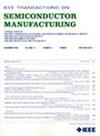Optimization of Void Defects at TiN/Si:HfO2 Interface for 3-D Ferroelectric Memory
IF 2.3
3区 工程技术
Q2 ENGINEERING, ELECTRICAL & ELECTRONIC
引用次数: 0
Abstract
In the 3D ferroelectric memory fabrication process, the outer Titanium nitride metal electrode and silicon doped hafnium-based ferroelectric layer will produce void defects at the interfaces, causing increased leakage and compromising device performance. These void defects are caused by the volume contraction during the phase transition process, which leads to tension at the outer interface of the 3D ferroelectric capacitor structure. Due to the unavoidable structural stress, it is necessary to optimize the interface bonding energy. First principles simulation revealed insufficient binding energy between titanium nitride and silicon doped hafnium oxide ferroelectric materials, while introducing an amorphous alumina interface layer can effectively improve the binding ability. Experimental verification has confirmed that using an amorphous alumina interface layer as an adhesive layer can successfully solve the interface void defects, thereby improving the ferroelectric properties in three-dimensional structures.优化三维铁电存储器的 TiN/Si:HfO2 接口空隙缺陷
在三维铁电存储器制造过程中,外层氮化钛金属电极和掺硅铪基铁电层会在界面处产生空隙缺陷,导致漏电增加,影响器件性能。这些空隙缺陷是由相变过程中的体积收缩引起的,从而导致三维铁电电容器结构的外部界面产生张力。由于结构应力不可避免,因此有必要优化界面结合能。第一原理模拟显示,氮化钛和掺硅氧化铪铁电材料之间的结合能不足,而引入非晶氧化铝界面层可有效提高结合能力。实验验证证实,使用非晶氧化铝界面层作为粘合层可成功解决界面空隙缺陷,从而改善三维结构的铁电特性。
本文章由计算机程序翻译,如有差异,请以英文原文为准。
求助全文
约1分钟内获得全文
求助全文
来源期刊

IEEE Transactions on Semiconductor Manufacturing
工程技术-工程:电子与电气
CiteScore
5.20
自引率
11.10%
发文量
101
审稿时长
3.3 months
期刊介绍:
The IEEE Transactions on Semiconductor Manufacturing addresses the challenging problems of manufacturing complex microelectronic components, especially very large scale integrated circuits (VLSI). Manufacturing these products requires precision micropatterning, precise control of materials properties, ultraclean work environments, and complex interactions of chemical, physical, electrical and mechanical processes.
 求助内容:
求助内容: 应助结果提醒方式:
应助结果提醒方式:


